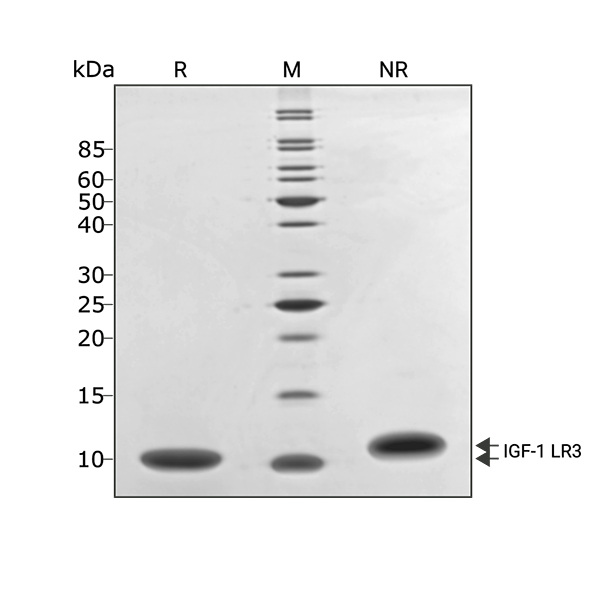 Recombinant bovine/porcine IGF-1 LR3 protein (Qk114-FG)
Recombinant bovine/porcine IGF-1 LR3 protein (Qk114-FG)Recombinant bovine/porcine IGF-1 LR3 protein (Qk114-FG)
Price range: £60.00 through £190.00
Bovine/porcine insulin-like growth factor 1 long arginine 3 (IGF-1 LR3) protein is a synthetic analog of IGF-1. The substitutions include an arginine substitution and an N-terminal protein extension. Consequently, IGF-1 LR3 has improved biological potency and extended half-life and can be used for the consistent, reproducible maintenance of pluripotent stem cells.
Qkine IGF-1 LR3 is a high quality food grade bioactive 9 kDa protein monomer, animal origin-free (AOF) and carrier-protein free (CF).
In stock
Orders are typically shipped same or next day (except Friday).
Easy world-wide ordering, direct or through our distributors.
Price range: £60.00 through £190.00
Buy online with secure credit card or purchase order. For any questions, please email orders@qkine.com
Summary:
- High quality IGF-1 LR3 protein
- 9 kDa
High quality food grade recombinant protein
>98%, by SDS-PAGE quantitative densitometry
Animal origin-free (AOF) and carrier protein-free
Expressed in E. coli
Manufactured in the UK under a food manufacturing HACCP regime
Lyophilized from acetonitrile, TFA
- Resuspend in sterile-filtered water at >50 µg/ml, add carrier protein if desired, prepare single use aliquots and store frozen at -20 °C (short-term) or -80 °C (long-term).
Featured applications:
Bovine and porcine stem cell expansion and maintenance
Bovine and porcine primary cell culture
Cell culture media optimization and replacement of insulin in defined media
Cellular agriculture and cultivated meat cell culture media optimization

Bioactivity was determined using the Promega serum response element luciferase reporter assay in transfected MCF-7 cells. Cells are treated in triplicate with a serial dilution of IGF-1 LR3 for 4 hours. Firefly luciferase activity was measured and normalized to the control Renilla luciferase activity. EC50 = 1.3 nM (11.7 ng/ml).
IGF-1 LR3 migrates as a single band at 10 kDa in non-reducing (NR) conditions and upon reduction (R). No contaminating protein bands are visible. Purified recombinant protein (3 µg) was resolved using 18% w/v SDS-PAGE in reduced (+β-mercaptothanol, R) and non-reduced (NR) conditions and stained with Coomassie Brilliant Blue R250.

Further quality assays
Mass spectrometry: single species with expected mass
Recovery from stock vial: >95%
Endotoxin: <0.005 EU/μg protein (below level of detection)
Full raw materials traceability, allergen analysis, CoO, CoA, beta-lactam-free and animal origin-free certification available
We are a company founded and run by scientists to provide a service and support innovation in stem cell biology and regenerative medicine. All our products are exceptionally high purity, with complete characterisation and bioactivity analysis on every lot.
Protein background
The insulin-like growth factors (IGFs) are a family of proteins with a similar structure to insulin. IGF-1 has an A and B chain connected by disulphide bonds, its similarity to insulin means it can bind with low affinity to the insulin receptor [1]. IGF-1 is a primary mediator of growth hormone (GH), with growth-promoting effects on most cells and tissues including skeletal muscle, cartilage, bone, liver, kidney, nerve, skin, hematopoietic, and lung [1]. IGF-1 exerts its biological effect through binding to the IGF1 receptor (IGF1R), its effect is modulated through interaction with a group of binding proteins (IGFBPs), which tend to inhibit the effect of IGF-1 [2]. Through IGF1R the Ras-MAPK and PI3 kinase signaling pathways are activated leading to increased cell proliferation and survival [2].
IGF-1 can be used to support maintenance of human embryonic stem cell (ESC) [3] and mesenchymal stem cell (MSC) cultures [3, 4].
Insulin-like growth factor long arginine 3 (IGF-1 LR3), is a widely used synthetic analog of IGF-1 with an arginine replacing glutamic acid at position 3 (arginine 3, R3), and an additional 13 amino acids at its N-terminus (long, L). IGF-1 LR3 retains the ability to bind IGF-1 and insulin receptors but has reduced binding affinity to insulin-like growth factor-binding proteins (IGFBPs). Consequently, it has improved potency and metabolic stability [5].
Additional resources
FAQ
IGF-1 LR3 is a modified form of IGF-1, it is more potent and stable than unmodified IGF-1.
IGF-1 LR3 can be used to replace IGF-1 in stem cell cultures. Increased potency and stability means less IGF-1 LR3 is needed compared to unmodified IGF-1.
IGF1R is linked to various cytoplasmic second messenger molecules including the RAS-MAPK and PI3K signaling networks.
IGF-1 LR3 binds to the IGF-1 receptor (IGF1R).
IGF-1 LR3 has an arginine instead of a glutamic acid at the third position in its amino acid sequence and an additional 13 amino acids at its N-terminus. IGF-1 LR3 remains an agonist of the IGF-1 receptor, but it has very low affinity for IGFBPs, which inhibit IGF-1, making it more potent. IGF-1 LR3 also has a significantly longer half-life than IGF-1.
IGF-1 LR3 is a synthetic protein and not naturally occurring.
Our products are for research use only and not for diagnostic or therapeutic use. Products are not for resale.
For use in manufacturing of cellular or gene therapy products. Not intended for in vivo applications.

Receive an Amazon gift voucher when you leave us a review.
£25, $30 or €30 for reviews with an image and £10, $15 or €15 for reviews without an image
